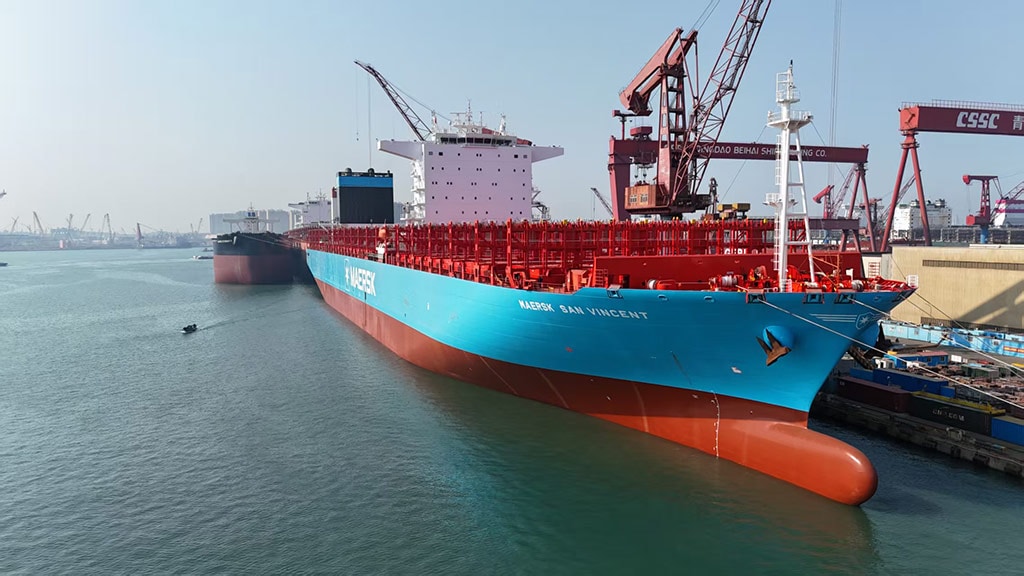Copenhagen, Denmark – In a large-scale programme involving 50 different shipowners, A.P. Moller – Maersk (Maersk) is – in close collaboration with the owners – retrofitting around 200 vessels in its time-chartered fleet. The main aim of the programme is to reduce the slot cost by improving fuel efficiency and cargo-carrying capacity leading to a decrease in both cost and greenhouse gas emissions.
Our medium- and long-term chartered fleet makes up a significant proportion of our operations as well as of our total fuel consumption. By working closely with our partners, we aim to implement solutions that not only reduce emissions but also enhance the overall competitiveness of our fleet.
Maersk has set the target of a 35% absolute reduction in its scope 1 greenhouse gas emissions by 2030 compared to the 2022 baseline year.
While fuel transition is needed to reach our long-term goal of net-zero emissions by 2040, investments in existing fleet efficiency enhancement technologies is a powerful tool to gain significant emissions reductions in the short term. Consequently, this strong emphasis on efficiency measures can deliver tangible progress towards our 2030 goal. That goes for owned as well as chartered vessels.
Partnering with vessel owners
In total, Maersk and time-charter partners have executed more than 1,500 individual projects across 200 vessels with 50 shipowners, and an additional 1,000 projects are in the process of execution scheduled to be finalised by 2027. The investment cost for these solutions is split between Maersk and the vessel owners.
We have from experience found that this model is a win-win. At Maersk, we can reduce both emissions and fuel costs, while the owners get the long-term value of a modernised vessel. Fleet renewal is often seen as new vessels replacing the old, but it is also about ensuring your existing vessels keep their competitive edge.
Given the scale of the project, it spans very different vessels in terms of size and configurations, also meaning that the retrofit tools being used vary.
Of the around 200 vessels being retrofitted, a common and significant change to the vessel configuration is the replacement of the propeller or bulbous bow. The integration of an optimally designed bulbous bow reshapes water flow around the hull to reduce drag and enhance hydrodynamic efficiency – ultimately lowering fuel consumption. Alongside this, the replacement of propellers combined with Pre-Swirl Devices plays a crucial role in maximising thrust while minimising energy loss.
Many of these ships were designed and constructed at a time when container vessels in general were sailing at faster speeds. To bring down fuel consumption, we have over the years introduced less compressed vessel schedules, but the propellers and bulbs optimized for faster speeds have been kept. There lies a big efficiency potential in replacing them.
Other retrofit solutions such as auxiliary engine waste heat recovery systems allow steam production from auxiliary engine heat, reducing the reliance on fuel-oil-fired boilers. Similarly, the installation of shaft generator systems cuts down auxiliary engine usage, contributing to significant fuel savings.
Cargo-carrying capacity is also being enhanced through a range of structural and technical improvements: elevating the wheelhouse to improve line of sight and increase intake, raising the lashing bridges, strengthening the vessel’s deadweight capacity for deeper drafts, and upgrading both lashing systems and loading computer functionalities.
About Maersk
A.P. Moller – Maersk is an integrated logistics company working to connect and simplify its customers’ supply chains. As a global leader in logistics services, the company operates in more than 130 countries and employs around 100,000 people. Maersk is aiming to reach net zero GHG emissions by 2040 across the entire business with new technologies, new vessels, and reduced GHG emissions fuels*.
*Maersk defines “reduced GHG emissions fuels” as fuels with at least 65% reductions in GHG emissions on a lifecycle basis compared to fossil of 94 g CO2e/MJ.
For further information, please contact:
